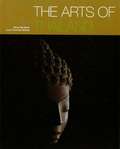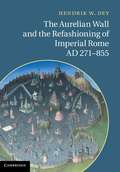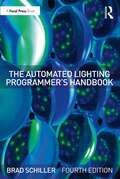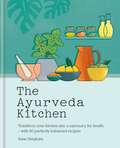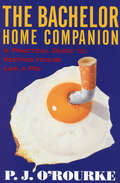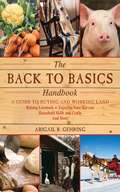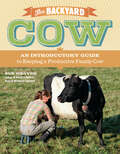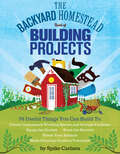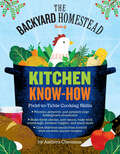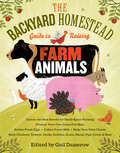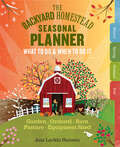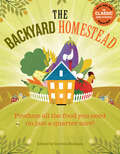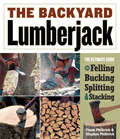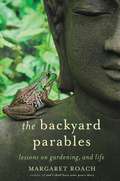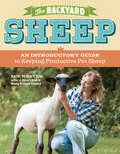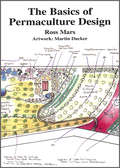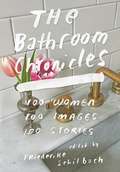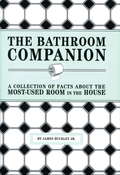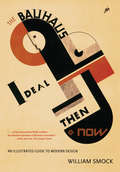- Table View
- List View
The Arts of Thailand
by Luca Invernizzi Tettoni Steve Van BeekFor over a thousand years, Thailand has been a cultural crossroads for the artistic traditions of India, Sri Lanka, Cambodia, and Indonesia, gradually evolving a unique style of artistic expression all its own. Based on exhaustive museum, library, and temple research, The Arts of Thailand covers every major form and period of Thai art and provides a complete overview of one of the world's richest artistic traditions.
The Aurelian Wall and the Refashioning of Imperial Rome, AD 271–855
by Hendrik W. DeyThis book explores the relationship between the city of Rome and the Aurelian Wall during the six centuries following its construction in the 270s AD, a period when the city changed and contracted almost beyond recognition, as it evolved from imperial capital into the spiritual center of Western Christendom. The Wall became the single most prominent feature in the urban landscape, a dominating presence which came bodily to incarnate the political, legal, administrative and religious boundaries of urbs Roma, even as it reshaped both the physical contours of the city as a whole and the mental geographies of 'Rome' that prevailed at home and throughout the known world. With the passage of time, the circuit took on a life of its own as the embodiment of Rome's past greatness, a cultural and architectural legacy that dwarfed the quotidian realities of the post-imperial city as much as it shaped them.
The Automated Lighting Programmer's Handbook
by Brad SchillerThe Automated Lighting Programmer’s Handbook, fourth edition, provides respected and clear coverage of the process of programming automated lighting fixtures from basic principles to advanced production preparations. This guide helps lighting programmers and designers with the creative and operational challenges they face in their rapidly evolving industry. Concepts, procedures, and guidelines to ensure a successful production are covered as well as troubleshooting, much needed information on workflows, technology, work relationships, console networking, digital lighting, and more. Chapters are peppered with advice and war stories from some of the most prominent lighting designers and programmers of today. The fourth edition is the most comprehensive yet: added topics include programming structure, advanced recording/editing, cloning, multi-cell fixtures, safety routines, GDTF, and pre-visualization. Deep explorations into the work of programmers from Earlybird and Broadway provide readers with timely real-world scenarios and advice. The information in this book is perfect for anyone interested in the programming of automated lighting in any market. From the beginner to the expert, the methodologies within provide simple, yet powerful tools to assist with any production. Lighting designers also will gain important knowledge about the procedures and concepts utilized by lighting programmers.
The Ayurveda Kitchen: Transform your kitchen into a sanctuary for health - with 80 perfectly balanced recipes
by Anne Heigham'Anne Heigham has brought the ancient, timeless wisdom of Ayurveda into these energizing recipes that nourish the doshas.Anne Heigham has brought the ancient, timeless wisdom of Ayurveda into these energizing recipes that nourish the doshas.' Vasant Lad, BAM&S, MASc, Ayurvedic Physician'Let food be your first medicine and the kitchen your first pharmacy.' Taittiriya UpanishadBy using the principles of Ayurveda, which is one of the fastest growing health practices, and a little vision, transform your kitchen into a space that nourishes your body, mind and soul.With this beautiful introduction to Ayurveda, learn how to use your kitchen as a natural pharmacy to improve your health and prevent imbalances with key Ayurvedic ingredients, 80 perfectly balanced vegetarian recipes and simple home remedies. Ayurveda aims to bring health back into balance, nourishing agni (metabolic fire) and prana (life force), while clearing ama (metabolic waste or 'sludge'). Just imagine fresh, vibrant herbs growing, seeds sprouting and pickles fermenting. Discover how to perform a kitchen sadhana at the beginning of each season, mix your own spice blends and balance recipes according to what you need and how you feel.Sections include:Introduction to AyurvedaAyurveda and seasonal eatingThe kitchen pharmacyRecipes from the Ayurveda kitchenRecipes include:Sweet potato and pea tortillaNourishing spiced pumpkin soupRefuelling rice and red lentil ballsCarrot and beetroot celebration cake
The Ayurveda Kitchen: Transform your kitchen into a sanctuary for health - with 80 perfectly balanced recipes
by Anne Heigham'Anne Heigham has brought the ancient, timeless wisdom of Ayurveda into these energizing recipes that nourish the doshas.Anne Heigham has brought the ancient, timeless wisdom of Ayurveda into these energizing recipes that nourish the doshas.' Vasant Lad, BAM&S, MASc, Ayurvedic Physician'Let food be your first medicine and the kitchen your first pharmacy.' Taittiriya UpanishadBy using the principles of Ayurveda, which is one of the fastest growing health practices, and a little vision, transform your kitchen into a space that nourishes your body, mind and soul.With this beautiful introduction to Ayurveda, learn how to use your kitchen as a natural pharmacy to improve your health and prevent imbalances with key Ayurvedic ingredients, 80 perfectly balanced vegetarian recipes and simple home remedies. Ayurveda aims to bring health back into balance, nourishing agni (metabolic fire) and prana (life force), while clearing ama (metabolic waste or 'sludge'). Just imagine fresh, vibrant herbs growing, seeds sprouting and pickles fermenting. Discover how to perform a kitchen sadhana at the beginning of each season, mix your own spice blends and balance recipes according to what you need and how you feel.Sections include:Introduction to AyurvedaAyurveda and seasonal eatingThe kitchen pharmacyRecipes from the Ayurveda kitchenRecipes include:Sweet potato and pea tortillaNourishing spiced pumpkin soupRefuelling rice and red lentil ballsCarrot and beetroot celebration cake
The Bachelor Home Companion: A Practical Guide to Keeping House Like a Pig
by P. J. O'Rourke"I always wanted to be a bachelor when I grew up. My friends may have had fantasies about raking the yard, seeing their loved ones in pin curlers and cleaning the garage on Sundays, but not me. I saw myself at thirty-eight lounging around a penthouse in a brocade smoking jacket. Vivaldi would be playing on the stereo. I'd sip brandy from a snifter the size of a fish tank and leaf through an address book full of R-rated phone numbers. ..." Always with tongue firmly in cheek, the author points out the trouble, for bachelors, with laundromats, cooking, shopping and everything else that goes along with managing a house. "Bachelor cooking is a matter of attitude. If you think of it as setting fire to things and making a mess, it's fun. It's not so much fun if you think of it as dinner. Fortunately, baloney, cheeseburgers, beer, and potato-chip dip provide all the daily nutrients bachelors are known to require. I mean, I hope they do."
The Bachelor Home Companion: A Practical Guide to Keeping House Like a Pig
by P. J. O'Rourke<p>From P. J. O'Rourke, bestselling author and expert bachelor, comes a hilarious look at domestic life. Or, as P. J. puts it, "This is a book about cooking, cleaning, and housekeeping for people who don't know how to do any of those things and aren't about to learn." <p>In addition to debunking popular myths about bachelors (they are in fact not creatures known to hang around the house in silk smoking jackets, sipping brandy from oversized snifters) P. J. offers some useful sections on cleaning—or how best to avoid doing it: "Spill something fresh on the floor because a slippery floor is much more like a clean, waxed floor than a stinky floor is."; "Every month or so, take the curtains down-and throw them away. Turn the lights off if you don't want the neighbors to see what you're doing. The same goes for slipcovers."; "Don't use Drano if a toilet gets clogged. <p>Remembering, the toilet is a dog's idea of Perrier. And you don't want a dog with a melted tongue."; "Sheets can be kept clean by getting drunk and falling asleep with your clothes on." In the inimitable style that has made him one of America's most popular humorists, P. J. provides an essential guide to the practical business of living in the modern world and proves that.</p>
The Back to Basics Handbook: A Guide to Buying and Working Land, Raising Livestock, Enjoying Your Harvest, Household Skills and Crafts, and More (Handbook Series)
by Abigail R. GehringAnyone who wants to learn basic living skills-the kind employed by our forefathers-and adapt them for a better life in the twenty-first century need look no further than this eminently useful, full-color guide. With hundreds of projects, step-by-step sequences, photographs, charts, and illustrations, The Back to Basics Handbook will help you dye your own wool with plant pigments, graft trees, raise chickens, craft a hutch table with hand tools, and make treats such as blueberry peach jam and cheddar cheese. The truly ambitious will find instructions on how to build a log cabin or an adobe brick homestead. More than just practical advice, this is also a book for dreamers- even if you live in a city apartment you will find your imagination sparked, and there's no reason why you can't, for example, make a loom and weave a rag rug. Complete with tips for old-fashioned fun (square dancing calls, homemade toys, and kayaking tips), this is the ultimate concise guide to voluntary simplicity.
The Backyard Cow: An Introductory Guide to Keeping a Productive Family Cow
by Sue WeaverYou don’t need acres of land to keep a cow healthy, happy, and productive. You can raise one right in your own backyard, producing more than enough milk for a single family — up to six gallons per day! The Backyard Cow covers everything you need to know, from selecting the right breed to understanding your cow’s behavior. With helpful advice on daily maintenance, milking, and bovine health care, you’ll soon be enjoying the pleasures of fresh milk, yogurt, cheese, and much more.
The Backyard Homestead Book of Building Projects: 76 Useful Things You Can Build to Create Customized Working Spaces and Storage Facilities, Equip the Garden, Store the Harvest, House Your Animals, and Make Practical Outdoor Furniture (Backyard Homestead)
by Spike CarlsenGardeners, small farmers, and outdoor living enthusiasts will love this compilation of 76 rustic DIY projects. From plant supports and clotheslines to a chicken coop, a greenhouse, and a root cellar with storage bins, most of the projects are suitable for complete novices, and all use just basic tools and easy-to-find materials. You&’ll find techniques to build whatever your outdoor world is missing, with additional tips to live sustainably, happily, and independently. Also available in this series: The Backyard Homestead, The Backyard Homestead Seasonal Planner, The Backyard Homestead Guide to Raising Farm Animals, and The Backyard Homestead Book of Kitchen Know-How.
The Backyard Homestead Book of Kitchen Know-How: Field-to-Table Cooking Skills (Backyard Homestead)
by Andrea ChesmanGrowing vegetables and raising livestock is only the beginning of a successful homestead — that fresh food goes to waste unless you can properly prepare, cook, and preserve it. Andrea Chesman shows you how to bridge the gap between field and table, covering everything from curing meats and making sausage to canning fruits and vegetables, milling flour, working with sourdough, baking no-knead breads, making braises and stews that can be adapted to different cuts of meat, rendering lard and tallow, pickling, making butter and cheese, making yogurt, blanching vegetables for the freezer, making jams and jellies, drying produce, and much more. You’ll learn all the techniques you need to get the most from homegrown foods, along with dozens of simple and delicious recipes, most of which can be adapted to use whatever you have available.
The Backyard Homestead Guide to Growing Organic Food: A Crop-by-Crop Reference for 62 Vegetables, Fruits, Nuts, and Herbs
by Tanya Denckla CobbThis essential guide to growing a bountiful food garden includes detailed seed-starting, growing, and harvesting information for 62 vegetables, fruits, and herbs, a complete companion-planting guide, and organic pest-control handbook. The latest addition to Storey's bestselling Backyard Homestead series, The Backyard Homestead Guide to Growing Organic Food is a one-stop reference for all the key information food gardeners need to grow a healthy, bountiful garden. Author Tanya Denckla Cobb presents key information based on extensive research and years of experience, including when to start seeds for each type of crop (and at what temperature), how far apart to space seedlings, how to tell when a crop is ready to harvest, and notes on preservation. The book features a comprehensive companion planting guide and an in-depth review of the most effective organic pest control practices, including recipes for how to make your own pest deterrent sprays.
The Backyard Homestead Guide to Raising Farm Animals: Choose the Best Breeds for Small-Space Farming, Produce Your Own Grass-Fed Meat, Gather Fresh Eggs, Collect Fresh Milk, Make Your Own Cheese, Keep Chickens, Turkeys, Ducks, Rabbits, Goats, Sheep, Pigs, Cattle, & Bees (Backyard Homestead)
by Gail Damerow Richard E. Bonney Nancy Searle Heather Smith Thomas Paula Simmons Malcolm T. Sanford Kelly Klober Darrell L. SalsburyEnjoy a weekend breakfast featuring eggs, bacon, and honey from your own chickens, pigs, and bees, or a holiday meal with your own heritage-breed turkey as the main attraction. Gail Damerow covers everything you need to successfully raise your own farm animals, from selecting the right breeds to producing delicious fresh milk, cheese, honey, eggs, and meat. Even with just a small plot of land, you can become more self-sufficient, save money, and enjoy healthy, delicious animal products. Also available in this series: The Backyard Homestead, The Backyard Homestead Book of Building Projects, The Backyard Homestead Seasonal Planner, and The Backyard Homestead Book of Kitchen Know-How.
The Backyard Homestead Seasonal Planner: What to Do & When to Do It in the Garden, Orchard, Barn, Pasture & Equipment Shed (Backyard Homestead)
by Ann Larkin HansenThis hardworking addition to the best-selling Backyard Homestead series offers expert advice on what tasks to do around your farm and when to do them — no matter where on the planet you call home. Author Ann Larkin Hansen sets the priorities for each area of the farm, including the barn, garden, orchard, field, pasture, and woodlot. For every critical turn of the year (12 in all), Hansen provides an at-a-glance to-do list along with tips and a more in-depth discussion of key topics for the season. Easy-reference charts, checklists, and record-keeping sections help you keep track of it all.
The Backyard Homestead: Produce all the food you need on just a quarter acre! (Backyard Homestead)
by Carleen MadiganThis comprehensive guide to homesteading provides all the information you need to grow and preserve a sustainable harvest of grains and vegetables; raise animals for meat, eggs, and dairy; and keep honey bees for your sweeter days. With easy-to-follow instructions on canning, drying, and pickling, you’ll enjoy your backyard bounty all winter long.
The Backyard Lumberjack: The Ultimate Guide To Felling, Bucking, Splitting And Stacking
by Frank Philbrick Stephen PhilbrickWhether you’re splitting a cord of wood for your fireplace or managing acres of woodland, The Backyard Lumberjack provides plenty of practical instruction and firsthand advice. Familiarize yourself with the proper equipment and safety gear, then learn how to fell, buck, split, and stack your own wood supply for the season. Veteran lumberjacks Frank Philbrick and Stephen Philbrick cover everything you need to know to bring a tree from the forest to your fireplace, safely and effectively.
The Backyard Parables: Lessons on Gardening, and Life
by Margaret RoachMargaret Roach has been harvesting thirty years of backyard parables-deceptively simple, instructive stories from a life spent digging ever deeper-and has distilled them in this memoir along with her best tips for garden making, discouraging all manner of animal and insect opponents, at-home pickling, and more.After ruminating on the bigger picture in her memoir And I Shall Have Some Peace There, Margaret Roach has returned to the garden, insisting as ever that we must garden with both our head and heart, or as she expresses it, with "horticultural how-to and woo-woo." In THE BACKYARD PARABLES, Roach uses her fundamental understanding of the natural world, philosophy, and life to explore the ways that gardening saved and instructed her, and meditates on the science and spirituality of nature, reminding her readers and herself to keep on digging.
The Backyard Sheep: An Introductory Guide to Keeping Productive Pet Sheep
by Sue WeaverRaise a flock of sheep in your backyard. Even with a limited amount of space, you can enjoy homegrown fleece and fresh milk, as well as the endearing company of these family-friendly animals. Sue Weaver provides all the instructions you need for selecting a breed; housing and feeding; harvesting fleece; and milking. With simple recipes for making cheese and yogurt, and tips on processing fleece for wool, you&’ll enjoy the varied and numerous rewards of keeping sheep.
The Baking Soda Companion: Natural Recipes And Remedies For Health, Beauty, And Home (Countryman Pantry)
by Suzy ScherrEveryone has baking soda on hand to help cookies rise and keep the pantry smelling fresh. But this simple compound also has dozens of other applications for health, cleaning, gardening, and more. <p><p> In The Baking Soda Companion, Suzy Scherr explains just how useful this all-natural pantry staple can be. Make extra-fluffy scrambled eggs, clean the coffee pot, soothe bug bites, mix up toothpaste and shampoo, remove stubborn grass stains, repel garden pests, and more. This is a straightforward, informative guide for anyone who wants to incorporate simple, affordable, and natural solutions into their day-to-day routine.
The Basics of Permaculture Design
by Ross Mars"The Basics of Permaculture Design", first published in Australia in 1996, is an excellent introduction to the principles of permaculture, design processes, and the tools needed for designing sustainable gardens, farms, and larger communities. Packed with useful tips, clear illustrations, and a wealth of experience, it guides you through designs for gardens, urban and rural properties, water harvesting systems, animal systems, permaculture in small spaces like balconies and patios, farms, schools, and ecovillages. This is both a do-ityourself guide for the enthusiast and a useful reference for permaculture designers.
The Bathroom Chronicles: 100 Women. 100 Images. 100 Stories.
by Friederike SchilbachOne hundred creative, intelligent, and interesting women--some well-known, some not--reveal their inner selves through candid, tender, and often humorous snapshots--both visual and textual--of a single object or corner of their bathroom. For many women, the bathroom is the most intimate of spaces. It is the place where we encounter ourselves in the mirror each morning and every night-brushing our teeth, applying make-up, fixing our hair, getting ready to face the day, or recede from it. THE BATHROOM CHRONICLES is a beautiful, chic, touching, and deeply feminine collection of photos and accompanying short stories (sometimes no more than a sentence or two) by women about their private spaces and most cherished possessions. Lena Dunham reveals the corner by the sink where she keeps her favorite pieces of jewelry, as well as her birth control. Erica Jong snaps her poodles and insists that they love her powder room and to "fluff up their hair" in front of the mirrors. Roz Chast reflects on a shelf in the corner that she purchased from a second-hand store. It's decorated with birds, because she loves birds, and a tiny emu that was given to her by a friend when she was in Australia. Like the bathrooms themselves each of these stories and images is unique--open, private, minimalistic, messy, and beautiful.
The Bathroom Companion
by James BuckleyIt's the most used room in the house--but how much do you know about it? Here's the first book about the bathroom written exclusively for the bathroom! Set it on the back of the tank and learn something new on every visit--amazing facts and figures from history, science, pop-culture, and more. Don't let you time in the bathroom be a waste!
The Bathroom: A Social History of Cleanliness and the Body (History of Human Spaces)
by Alison K. HoaglandThe Bathroom: A Social History of Cleanliness and the Body is the first scholarly treatment of the American bathroom--as a space in the house, through nearly two centuries. After a brief nod to precedents set by other countries and to elements of the bathroom that may be placed in different parts of the house, this book traces the development of the bathroom in the American house since the Civil War, when the bathroom began to take shape. <p><p> The bathroom is considered in light of many socially relevant themes, such as cleanliness, sanitation, technology, and consumerism. Taken as a whole, the book bridges the gap between the public and private infrastructure of the bathroom and reveals the ways in which the space transforms its occupants into consumers. Its language is jargon-free, making it ideal for students, general readers, and researchers.
The Bauhaus Ideal Then and Now: An Illustrated Guide to Modern Design
by William SmockThe Bauhaus Ideal is both a picture book and a guidebook to the fascinating and enduring legacy of modernist design, and to the continuing influence of Bauhaus on interior design—not just on architecture, but also on furniture, glassware, tableware, and kitchen utensils: the whole range of domestic arts.This unique volume introduces modern design principles and examines them from an historically critical perspective. It concludes with some ideas for melding modern solemnity with postmodern irony. And in each phase the illustrations speak as eloquently as the text—the whole serves as a beautifully illustrated design memo.
The Beautiful Edible Garden: Design A Stylish Outdoor Space Using Vegetables, Fruits, and Herbs
by Stefani Bittner Leslie BennettFrom the founders of landscape design firm Star Apple Edible & Fine Gardening in the San Francisco Bay Area comes a stylish, beautifully-photographed guide to artfully incorporating organic vegetables, fruits, and herbs into an attractive modern garden design.We've all seen the vegetable garden overflowing with corn, tomatoes, and zucchini that looks good for a short time, but then quickly turns straggly and unattractive (usually right before friends show up for a backyard barbecue). If you want to grow food but you don't want your yard to look like a farm, what can you do? The Beautiful Edible Garden shares how to not only grow organic fruits and vegetables, but also make your garden a place of year-round beauty that is appealing, enjoyable, and fits your personal style. Written by a landscape design team that specializes in artfully blending edibles and ornamentals together, The Beautiful Edible Garden shows that it's possible for gardeners of all levels to reap the best of both worlds. Featuring a fresh approach to garden design, glorious photographs, and ideas for a range of spaces--from large yards to tiny patios--this guide is perfect for anyone who wants a gorgeous and productive garden.
